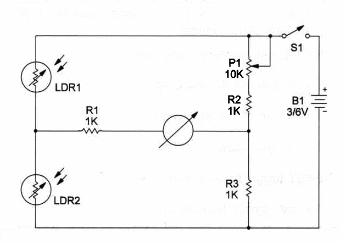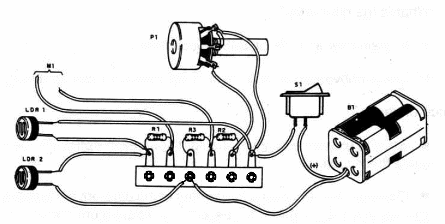This device can be used to compare two light sources by their intensities.
Several optical experiments can be conducted using this. You can compare colors of surfaces by reflected light or compare colors using special filters.
The sensors used are CdS photoresistors or LDRs (Light Dependent Resistors) that have peak sensitivity in the red part of the spectrum (7350 angstroms or 735 nm).
As the name suggests, the LDR has a resistance which varies as light falls on its sensitive surface.
As the light intensity increases, resistance falls. In total darkness resistance can be high as 1,000,000 Ω or more. Illuminated by direct solar light, the resistance falls to 100 Ω or less.
Our circuit is a simple Wheatstone Bridge equilibrated by two LDRs and an adjustable potentiometer (P1).
When the two LDFts are receiving the same amount of light, P1 can be adjUsted to get a null indication on the ammeter (M1).
If we use one LDR as reference, we can compare another source of light with this by using the other LDFl as sensor.
A new adjustment of P1 can reveal the difference between the two light sources.
The schematic diagram of the light comparator is shown in figure 1.

No transistors are used in this project-only resistors.
Components layout, using a terminal strip as chassis, is shown in figure 2.

The terminal strip can be fixed in the plastic box using screws. Wires to the sensor can be as long as 6 feet without instability problems.
The LDRs should be mounted into two small opaque tubes to receive light from different sources without outside interference.
M1 should be a zero-center microammeter. A 50-0-50 µA microammeter would be suitable.
The circuit can be powered from two or four AA cells, and current drain is very low, extending battery life to many months.
Light Comparator
LDR 1, 2 - Common 1cm LDRs (Light Dependent Resistors) or CdS photosensors
M1 - 50-0-50 µA ammeter - see text
R1, 2 - 1,000 ohm, ¼ W, 5% resistor
R3 - 4,700 ohm, ¼ W, 5% resistor
P1 - 10,000 ohm potentiometer
S1 - SPST toggle or slide switch
B1 - 3 to 6V - two or four AA cells
Ideas to Explore
To learn more about the circuit or to get better performance:
Use other types of sensors, such as phototransistors in the circuit. What is the difference?
Explain how an LDR or CdS cell operates.
Use a convergent lens in front of the cells for more sensitivity.
Science projects:
Several experiments involving light sources in optics can be made using this circuit.
Compare the reflections from paper using different but equal-power light sources, such as incandescent and fluorescent. Which of them has the better performance?
It is possible to change this circuit into a temperature comparator. Just replace the LDRs with NTCs.



